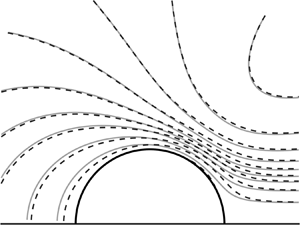Article contents
Rapid distortion theory of turbulent flow around a porous cylinder
Published online by Cambridge University Press: 11 March 2021
Abstract

The distortion of homogeneous isotropic turbulence interacting with a porous cylinder is calculated by means of the rapid distortion theory (RDT). The porous treatment, characterised by a constant static permeability, is modelled as an impedance boundary condition accounting for the Darcy's flow within the body. The RDT algorithm is first validated through comparisons with published velocity measurements in the stagnation region of an impermeable cylinder placed downstream of a turbulence grid. Subsequently, the impact of porosity on the velocity field is investigated through the analysis of the one-dimensional spectra at different locations near the body and the velocity variance along the stagnation streamline. The porous surface affects the incoming turbulence distortion near the cylinder by reducing the blocking effect of the body and by altering the vorticity deformation caused by the mean flow. The former leads to an attenuation of the one-dimensional velocity spectrum in the low-frequency range, whereas the latter results in an amplification of the high-frequency components. This trend is found to be strongly dependent on the turbulence scale and influences the evolution of the velocity fluctuations in the stagnation region. The porous RDT is finally adapted to model the turbulence distortion in the vicinity of the leading edge of a NACA-0024 profile fitted with melamine foam. The good agreement between the calculations and the experimental results demonstrates that the present methodology can improve the understanding of the physical mechanisms involved in the aerofoil-turbulence interaction noise reduction through porosity and be instrumental in designing such passive noise-mitigation treatments.
JFM classification
- Type
- JFM Papers
- Information
- Copyright
- © The Author(s), 2021. Published by Cambridge University Press
References
REFERENCES
- 21
- Cited by





